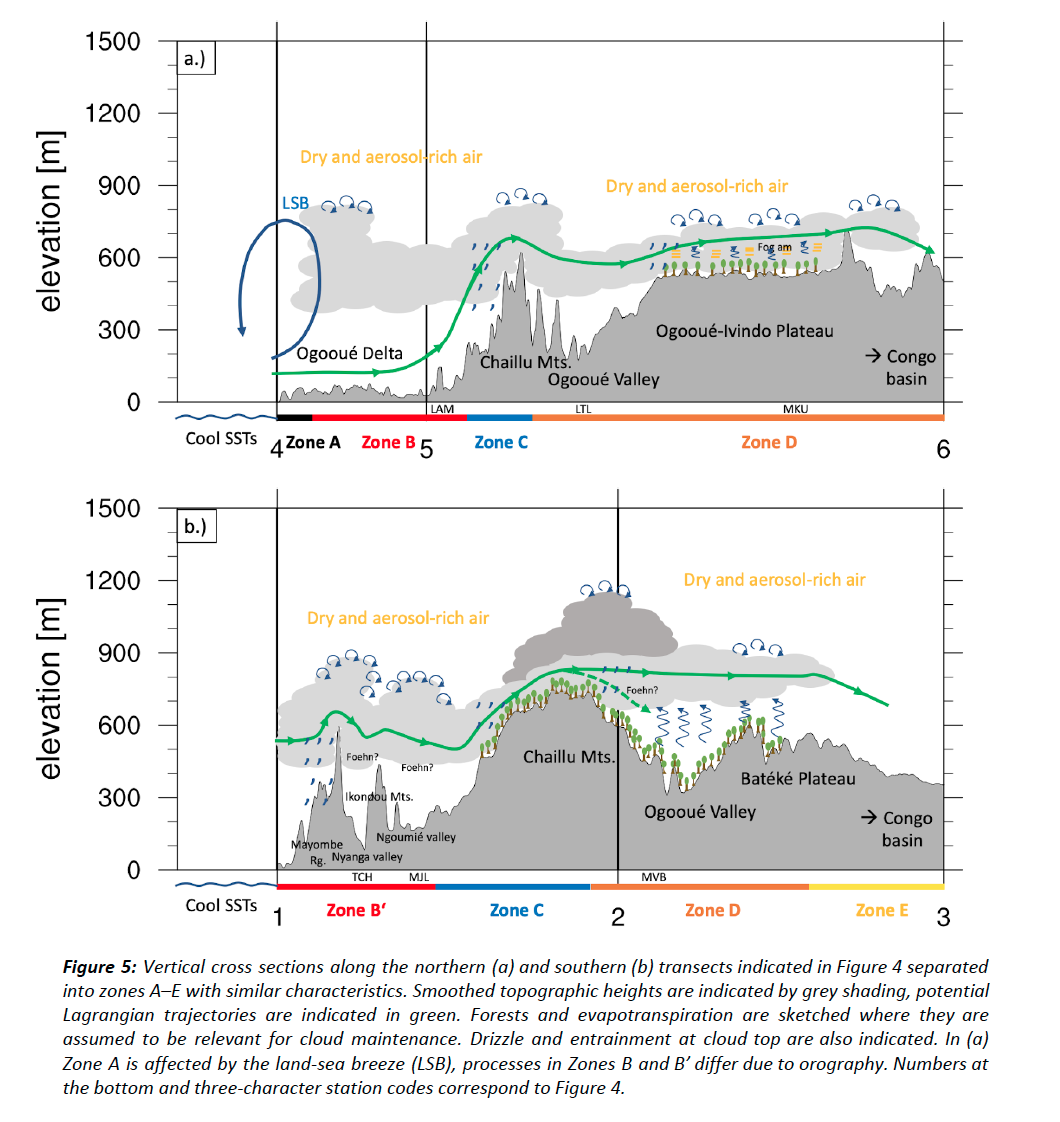DYVALOCCA - Dynamics, variability and bioclimatic effects of low clouds in western Central Africa
- Contact:
Prof. Dr. A. Fink, Prof. Dr. P. Knippertz
Researcher: R. Aellig - Funding:
Deutsche Forschungsgemeinschaft (DFG)
- Partner:
PI: Dr. Nathalie Philippon, Institut des Géoscience de l’Environment (IGE), Grenoble, France (funded by Agence Nationale de la Recherche, ANR France)
CO-PI: Prof. Jean-Damien Maloba, University Omar Bongo, Libreville, Gabon
- Startdate:
2019
- Enddate:
2022
Description of the project
Low-level clouds are key components in many regions but are usually not well represented in weather and climate models. Recently it has been shown that an extensive low-level cloud cover (LCC) develops during the June-September main dry season in western equatorial Africa, from the coastal plains of Gabon and Congo-Brazzaville to the inland plateaus downstream of the Chaillu mountains. Such a cloudy main dry season – which is the longest (~4 months) and driest (<1mm/day) in Central Africa– is unique in the moist tropics and likely explains the presence of the densest evergreen forests in this region.
As paleoclimatic studies indicate a high instability, any reduction of the LCC due to climate change may represent a major tipping-point for forest cover and functioning, but so far the few existing studies on the region have concentrated on the rainy seasons. Therefore there is an urgent need to better understand the presence, variability and bioclimatic effects of the LCC in western equatorial Africa in the current climate and to provide a robust assessment of its future evolution under climate change. This constitutes the main aims of the DYVALOCCA project.
To achieve these aims, an international consortium composed of French, German and Gabonese partners (plus external collaborators from UK, US and Belgium) has been built including meteorologists, climatologists, atmospheric modelers as well as experts in clouds remote sensing and forests functioning. The consortium will conduct a field campaign, acquire existing in-situ observations and utilize satellite and re-analyses data for diagnostic and modeling analyses.
The meteorological processes driving the LCC formation and dissolution at the diurnal scale will be studied from the synergistic analysis of historical in-situ data, a dedicated field campaign in July-August 2021 at Lékédi Park (Gabon) and atmospheric modeling activities. A focus will be put on two ocean-land transects to determine the extent to which processes are different between the coastal plains, the windward slopes of the Chaillu mountains and inland plateaus. Results will be compared to a recently developed conceptual model for LCC over southern West Africa.
The intraseasonal to interannual variability of LCC will be characterized from the analysis of long-term in-situ data and satellite estimates. Variations in the timing, i.e. seasonal onset and retreat as well as intraseasonal breaks, and in the inland extent of the LCC will be documented. Moreover the atmospheric and oceanic forcings at play will be explored. Approaches based on weather types and equatorial waves will be used to understand atmospheric dynamical states involved in the intraseasonal variations of LCC. The impact of local to regional sea surface temperatures on the LCC development and interannual variability will be assessed, coupling statistical analyses and dedicated sensitivity experiments with a regional climate model.
Lastly the effect of low clouds on light and water availability on forest functioning will be explored based on in-situ measurements acquired at Lékédi Park. Results will be compared with those obtained from measurements in northern Congo, where the dry season is sunny, and with outputs from a simple two-reservoirs water balance model adapted for the region. Water balance analyses will inform on the compensation or amplification effects of rains vs potential evapotranspiration both modulated by the LCC, on the water deficit.
Results from DYVALOCCA will lead to the first conceptual model for low-cloud formation and dissolution in western equatorial Africa, provide a basis for development of intraseasonal to seasonal forecasts of LCC variations, and quantify the water and light constraints underneath the LCC. DYVALOCCA will also give direction for an evaluation of climate change simulations with a focus to inform the assessment of tipping-points for the evergreen forests in past and future climates.

